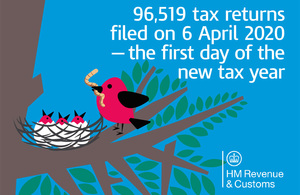Fascinating facts about Self Assessment
HM Revenue and Customs shares some little-known facts about Self Assessment ahead of the 31 January 2021 deadline.

Did you know almost 100,000 people filed their tax returns on 6 April 2020, which is the first day of the tax year?
With the 31 January 2021 deadline fast approaching, HM Revenue and Customs (HMRC) shares some little-known facts about Self Assessment tax returns.
The April ‘early birds’ are not the only ones to make HMRC’s list of Self Assessment facts; it is also 20 years since the tax authority introduced online tax returns. In 2001, 38,000 online tax returns were filed and this year, HMRC estimates around 11 million online tax returns – quite the increase and in line with the digitisation of the tax system.
Find help and support on GOV.UK for customers completing their Self Assessment tax return.
HMRC’s 7 Self Assessment facts are:
- 96,519 people filed their tax return on 6 April 2020 (first day of the tax year)
- it’s the 20th anniversary of Self Assessment internet filing, the service began on 3 July 2000 – with 38,000 individuals successfully sending their digital tax return by 31 January 2001
- in January 2011, 3.4 million taxpayers completed a Self Assessment tax return online - this has increased to an estimated 5 million in January 2021
- this year’s deadline (31 January 2021) is on a Sunday. The last time the deadline was on a Sunday was in 2016
- last year, the busiest filing day was 31 January with 702,171 returns completed
- the peak hour for filing last year was between 16:00 to 16:59 on 31 January when 56,969 customers filed
- HMRC has increased the self-serve Time to Pay threshold to £30,000 to help Self Assessment customers spread the cost of their tax bill
Karl Khan, HMRC’s Interim Director General for Customer Services, said:
It’s 20 years since Self Assessment online was introduced and it’s how the vast majority of customers complete their tax return these days. Fewer and fewer people are doing it on paper each year.
There’s still time for customers to complete their tax return before the deadline, and help and support is available on GOV.UK.
HMRC expects more than 12.1 million people to complete a Self Assessment tax return. Figures released earlier this month revealed that 55% of customers have already filed their returns, with more than 6.2 million choosing to submit online (93% of all returns filed).
Once customers have completed their tax return, and know how much tax is owed, they can set up their own payment plan to help spread the cost of their tax liabilities.
They can use the self-serve Time to Pay facility to set up monthly direct debits online.
This year, in light of the additional pressures caused by COVID-19, HMRC has increased the self-serve Time to Pay threshold to £30,000 to help Self Assessment customers spread the cost of their tax bill. Interest will be applied to any outstanding balance from 1 February 2021.
To see if they’re eligible, customers can visit GOV.UK to find out more about paying through instalments.
Be aware of copycat HMRC websites and phishing scams. Customers should always type in the full online address www.gov.uk/hmrc to get the correct link for their Self Assessment tax return online securely and free of charge.
They also need to be alert if someone calls, emails or texts claiming to be from HMRC, saying that they can claim financial help, are due a tax refund or owe tax - it might be a scam. Check GOV.UK for information on how to recognise genuine HMRC contact.
Further information
See more information about Self Assessment.
Find help and support on GOV.UK or through the HMRC app for customers completing their Self Assessment tax return.
If a customer’s Self Assessment debts are more than £30,000, or they need longer than 12 months to pay their debt in full, they may still be able to set up a Time to Pay arrangement by calling the Self Assessment Payment Helpline on 0300 200 3822
To protect against identity fraud customers must verify their identity when accessing HMRC’s online services. They must have two sources of information including:
- credit reference agency data
- tax credits
- P60/payslip
- UK passport
Customers can also check on GOV.UK whether they need to declare, or possibly pay tax on any ‘casual’ income they receive. The new interactive guidance is quick and easy to use and explains what individuals need to do if they receive non-PAYE income
Follow the National Cyber Security Centre’s six essential steps to keep yourself and your business secure online by visiting CyberAware.gov.uk.